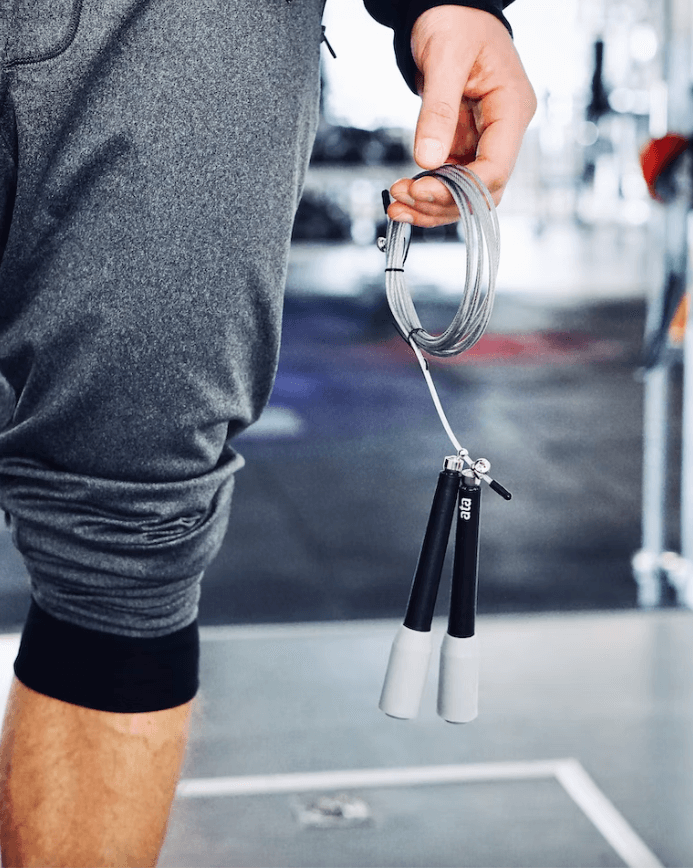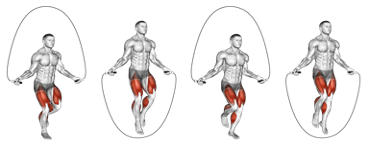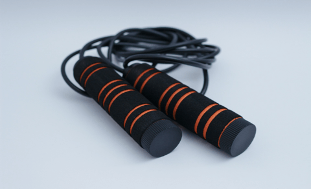Indeed, it does, subject to certain additional conditions.

Working out with rope is an exceptionally viable type of activity that can add to a better and fitter body. Hopping draws in different muscle gatherings, including the legs, arms, back, and center, making it a full-body exercise. Research has shown that only 10 minutes of bouncing rope consumes a similar number of calories as running an eight-minute mile, making it a viable method for getting thinner and decreasing stomach fat.[1]
Keeping up with great equilibrium and coordination while bouncing rope enacts the center muscles, including muscular strength. This center muscle commitment can help tone and reinforce muscular strength, which can prompt stomach fat misfortune over the long haul. Furthermore, working out with rope is an extreme focus workout, which can help digestion, consume more calories, and increment fat consumption. Subsequently, working out with rope is viable in lessening paunch fat and advancing weight reduction.
In addition, working out with rope is a low-influence workout, meaning it is doubtful to cause joint agony or injury than high-influence activities like running. Working out with rope likewise reinforces bones and joints, which can assist with forestalling long-haul wounds.[1]
Working out with rope is likewise a helpful and cheap type of activity that should be possible anyplace and doesn’t need extraordinary gear or a costly rec center participation. It very well may be effortlessly integrated into the everyday daily practice, whether during a mid-day break at work or while sitting in front of the television at home.
In any case, individual factors, for example, digestion, diet, and normal activity can influence the outcomes. Subsequently, working out with rope ought to be joined with a solid eating routine and different types of activity for ideal outcomes.
At last, creating working out with rope as an everyday daily practice and joining it with other sound propensities can diminish stomach fat, get thinner, and work on general well-being and health. Working out with rope is a viable, helpful, and low-influence type of activity that can add to a better, fitter body.
“Skipping is an old-school exercise that never goes out of style. It’s simple, effective, and it works.” – Mike Tyson
Instructions for Performing Jump Rope Exercise

Image Source
(
Jump Rope Alternatives: How to Target the Same Muscles
)
Working out with rope is a highly effective and practical form of physical activity. However, proper technique is crucial for optimal performance and minimizing the risk of injury. Therefore, the following fundamental steps and tips are recommended for jumping rope.
Skipping Fundamentals:
1. Start by remaining with your feet together and your hands at your sides.
2. Swing the rope all over on the floor, utilizing your wrists to pivot the rope.
3. At the point when the rope is on your feet, get around the rope with the two feet, arriving on the bundles of your feet.
4. At the point when you land, hop again to stay away from the rope and prepare for the following leap.
5. Rehash stages 2-4, keeping a consistent speed and hopping with the two feet.
Skipping Improvement Tips:
1. Keep your elbows near your body and your wrists loose as you swing the rope.
2. Bounce sufficiently high to clear the rope and keep your leaps light and springy.
3. Connect with your center and keep your shoulders loose to keep up with a great stance.
4. Land delicately on the bundles of your feet to lessen the effect on your joints.
5. To keep up with balance and stay away from neck strain, keep your look straight ahead and your jawline level.
6. When you know all about the fundamental procedure of bouncing rope, you can start to integrate further developed moves like hybrids, double unders, and side swings.
7. Begin slowly and steadily increment your endurance and ability level over the long run.
It’s critical to work out with rope accurately to amplify the advantages of this basic however compelling activity. Integrating these fundamental stages and tips can assist with guaranteeing protected and effective execution, which can prompt better wellness and generally speaking well-being.
“Skipping is the simplest, most effective exercise you can do anywhere, anytime.” – Jimmy Kimmel, television host, and comedian.
What is the recommended number of jumps per day for optimal benefits?

While involving working out with jumping rope as fat-loss equipment, it’s critical to consider that the quantity of jumps you do each day is just a single piece of the bigger condition. Achieving and maintaining a healthy weight necessitates consideration of overall levels of physical activity, dietary habits, and lifestyle behaviors.[2]
While jumping rope can provide a great cardiovascular workout that aids in calorie burning, it is crucial to begin slowly and gradually increase endurance over time. Beginners should commence with only a few minutes of continuous jumping and gradually progress to longer durations. This approach not only helps prevent injury but also enables the body to adapt to the exercise’s demands.
As comfort and proficiency in jumping rope increase, more advanced moves or faster jumping can be incorporated into workouts. However, it is vital to listen to the body and avoid pushing beyond personal limits.

Incorporating skipping rope into a well-rounded exercise and nutrition plan has been shown to yield significant outcomes. Specifically, individuals are advised to perform a 10-15 minute skipping routine at least 3-5 times per week to achieve notable results. A recent study published in the Journal of Sports Science & Medicine indicated that women who performed a ten-minute daily skipping routine, five times per week, over a six-week period, observed a statistically significant reduction in their waist-to-hip ratio and body fat percentage.
While skipping can contribute to an overall reduction in body fat, it is important to note that spot reduction, or targeted fat reduction, is not a feasible outcome. For instance, while skipping can aid in decreasing abdominal fat, it is not capable of targeting fat loss in a specific body region.[4]
In addition to incorporating skipping into an exercise routine, a balanced and healthy diet, as well as consistent physical activity involving both cardiovascular and strength training, are critical for achieving and maintaining a healthy weight and reducing abdominal fat.
It is essential to recognize that targeted fat reduction is not achievable through performing specific exercises. Instead, a consistent physical activity regime, healthy nutrition practices, and a caloric deficit are fundamental to attaining a more toned and lean physique.

Conclusion
In essence, integrating the practice of jumping rope into your fitness regimen can present itself as an enjoyable and efficacious means of attaining your weight loss aspirations. Nevertheless, it is crucial to undertake this endeavor in a gradual manner, heedful of your body’s responses, and complement it with other salubrious lifestyle practices to attain the most favorable outcomes.
“Skipping is one of the most effective and fun ways to keep fit and lose weight.” – Holly Willoughby, television presenter, and author
FAQ
Q:
Is skipping good for weight loss and possibly alone reduces belly fat?
A:
Yes, skipping is effective for weight loss when combined with a healthy lifestyle. It’s a high-intensity exercise that engages multiple muscle groups and burns calories. Skipping also increases muscle mass, and metabolism, and can help target belly fat for a slimmer appearance. Skipping can target belly fat by engaging core muscles, but it may not be enough on its own. A healthy diet and lifestyle should be combined with skipping for the best results.
Q:
How often should I skip to lose weight?
A:
Aim for at least 30 minutes of skipping as a moderate to high-intensity exercise daily to achieve weight loss benefits. It’s recommended to incorporate different jumps and variations to challenge your muscles and avoid boredom.
Q:
Can skipping harm joints?
A:
Skipping is high-impact and can be harmful to joints if done incorrectly or with improper footwear. Gradually increase the intensity, invest in a good jump rope, and warm up and cool down properly to reduce the risk of injury.[5]
Q:
Can skipping be done at any age?
A:
Skipping is safe and suitable for all ages, but it’s crucial to exercise caution and seek advice from a fitness professional before starting, particularly for older adults or those with health conditions. Adjustments to the routine may be required to accommodate individual needs and limitations.
References
1. “Tang, Z., Ming, Y., Wu, M., Jing, J., Xu, S., Li, H., & Zhu, Y. (2021). Effects of caloric restriction and rope-skipping exercise on cardiometabolic health: A pilot randomized controlled trial in young adults.
https://www.ncbi.nlm.nih.gov/pmc/articles/PMC8467906/
2. Hall, K. D., Heymsfield, S. B., Kemnitz, J. W., Klein, S., Schoeller, D. A., & Speakman, J. R. (2012). Energy balance and its components: Implications for body weight regulation. The American Journal of Clinical Nutrition, 95(4), 989–994.
https://doi.org/10.3945/ajcn.112.036350
3.Eler, N., & Acar, H. (n.d.). The effects of the rope jump training program in physical education lessons on strength, speed, and VO2 max in children.
https://files.eric.ed.gov/fulltext/EJ1170647.pdf
4. Vispute, S. S., Smith, J. D., LeCheminant, J. D., & Hurley, K. S. (n.d.). The effect of abdominal exercise on abdominal fat.
https://pubmed.ncbi.nlm.nih.gov/21804427/
5. García-Pinillos, F., Lago-Fuentes, C., Latorre-Román, P. A., Pantoja-Vallejo, A., & Ramirez-Campillo, R. (2019). Jump-rope training: Improved 3-km time-trial performance in endurance runners via enhanced lower-limb reactivity and foot-arch stiffness. International Journal of Sports Physiology and Performance, 14(1), 69-76.
https://pubmed.ncbi.nlm.nih.gov/32163923/

 By myulikeadmin
By myulikeadmin



